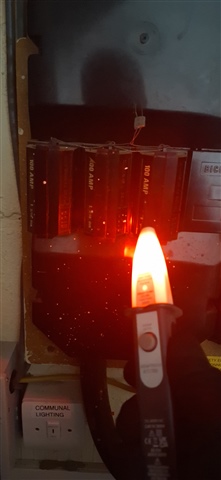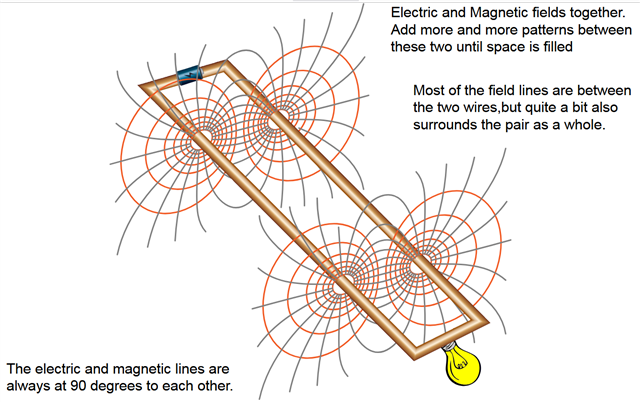i have come across black cut out fuses that light up my single pole tester, but only on the label.
my 2 pole tester does not light up from label to MET.
is this my single pole tester being over sensitive or should i call 105?
i have come across black cut out fuses that light up my single pole tester, but only on the label.
my 2 pole tester does not light up from label to MET.
is this my single pole tester being over sensitive or should i call 105?
Is that a non-contact sensor? I.e. would you expect it to light stroking the jacket of a dry PVC single insulated wire with a copper core that was live ? If so there is probably nothing to worry about - there is always some electric field around live parts and a cut out is a place where the spacing between the live parts and the associated neutral/earth is wider than normal, so the volume where that field will be detectable is larger. However, if the probe is one that normally only lights when you actually connect its tip to a live part, then assuming its not dripping wet, you may be looking at plastic that is starting to lose its insulating properties. Even so degrading insulation not really dangerous until a thumbprint size contact picks up a good fraction of a mA. (*)
The fact the other sensor shows no response suggests if there is any unusual leakage developing at all, it's not yet at a significant level.
Mike.
* and at that point, avoid touching it with your thumb or finger tips while other bits of you are solidly earthed - you may only feel a tingle, or maybe worse ... ;-)
I assume this is a CONTACT tester and not a NON-Contact type unit. I also ASSUME on the service head you have made contact at several points on the service head. Some people use a clockwise method and make contact a minimum of 10 times.
I would say it would be prudent to cal 105 and see what they say when you explain the issue. They may decide to change the cut out fuse to a GRP free of Charge
Yes it's a single pole contact tester, it only lights up on the label, it's in a locked cupboard and my 2 pole tester says nothing there to earth
Ive got the kewtech contact tool as well and yes it does give false positives, however it makes you double check for voltage , I’ve had several give 50v or so when you test to earth with the mft tester as well .
It made me go back to the van and get a 2 pole tester, there is a high field strength here, my non contact volt stick lights up 150mm away
This means that L and N are well separated - if you like to imagine the field lines between a pair of wires as they pull apart, the further of the electric field lines fly off before returning, and some dont return at all, but head for the plate at the end of the universe, or local earth....
This illustration is from https://cococubed.com/images/energy/circuit_eb_fields.pdf The magnetic fields (orange/brown - where a compass would point if you put it ther) are proportional in strength to the current, while the Electric fields (black, along which a charge would feel a force if placed at that point) are proportional to the voltage.
The closer the wires the more intense the electric field between them, and the less there is 'hanging out' as it were. As a very approximate rule of thumb once you get out to a distance of a few times the conductor centre to centre spacing, it has all but died away. But in some cut out designs, the spacing is an inch or two, so the field is very noticeable/ detectable out to a few times that... 
PS
This illustrates a DC. If it is an AC and a high enough frequency, then the fields at any snapshot in time, are all slightly offset in phase along the wire, completing a full cycle of phase shift over a distance of one wavelength. Not a big issue at 50Hz unless you are wiring a continent or across oceans, the wavelength at 50Hz is 6 megametres (6,000 km) (1GHz is 300mm 1MHz is 300m. 1Hz is 300Mm etc). Earth radius at equator is ~ 7Mm.
Mike.
edited for silly typo..
There was something posted recenetly abiout this phenomena - maybe on eefix or somewhere like that. Basically, they said that some of the older phenolic fuseholders were beginning to break down and become conductive, albeit only slightly. The proffered advice was to informn the DNO and let them make the judgement as to whether or not a new grey plastic cut out replacement was required.
yes, and that's why I asked if it was a contact probe - if it had been, then significant current could have been flowing through the slowly oxidizing resin, and it would then be quite nasty. Sounds like this was not doing that, this time at least.
The saving grace is that the degradation of the resin is quite slow and it takes many years to go from a barely perceptible leakage to something that should be a real concern.
In the meantime non contact probes which measure field, can be triggered just because the field is unusually high.
Mike.
Mike,
Sorry to quibble - and it's far beyond prctical relevance for power transmission - but I make the wavelength of 50Hz energy to be 6 megametres (rather than 60).
Excuse my going slightly off-topic: I'm encouraged that megametres are used by someone else than me. Even though they're preferred SI units, and mega-anything-else is freely used, and that Mm's are ideal for such things as planet-wide dimensions (e.g. distance to the Moon is ~400 Mm), most people insist on working in thousands of kilometres.
On second thoughts, the reluctance may be due to the possibility of (very unlikely) confusion between Mm and mm.
David.
quite right. I've gone in and edited it. - and I should have spotted it as obvious because of the Schumann resonances - the lowest is 7Hz or so.
Thanks for spotting that. M.
We're about to take you to the IET registration website. Don't worry though, you'll be sent straight back to the community after completing the registration.
Continue to the IET registration site